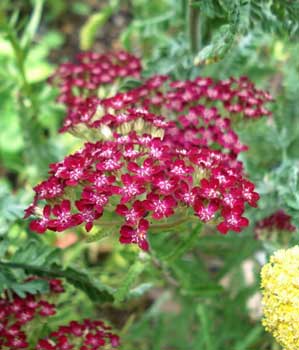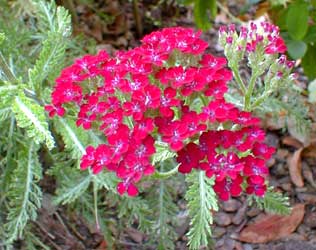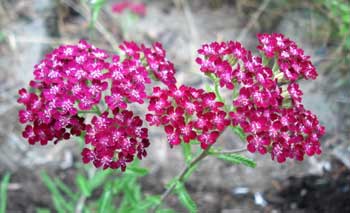
'Summerwine'
Yarrow
"Herbs self-sown,
And fruitage gathered from the chestnut wood,
Nourish the sufferers."
-William Wordsworth
(1770-1850)
(1770-1850)
 Achillea millefolium 'Summerwine' yarrow or milfoil is one of the German Galaxy series with sturdy upright stems not prone to lodging. It's a recipient of the Award of Garden Merit. It has claret or wine-red racemes that slowly fade to pink or mauve, each flower in the flat-topped raceme having a pale center which enlarges as the raceme ages.
Achillea millefolium 'Summerwine' yarrow or milfoil is one of the German Galaxy series with sturdy upright stems not prone to lodging. It's a recipient of the Award of Garden Merit. It has claret or wine-red racemes that slowly fade to pink or mauve, each flower in the flat-topped raceme having a pale center which enlarges as the raceme ages.It starts blooming anywhere from late June to mid-July (when the first photo was taken), or shortly after most of the other yarrows are well under way, & continues to bloom right on through the first few frosts of autumn. The second photo is from August's end, showing fresh & fading blossoms together. It's extremely cold-hardy, & grows best in zones 4 through 8.
Leafy flower stems reach a good two feet tall or a little higher, with feathery semi-evergreen basal leaves. For fresh bouquets, most of the leaves along the stems should be kept rather than stripped off, for the sake of the spicy redolence they bring into the house.
My great-grandmother would dry cut yarrows by hanging them upside down from the ceiling, near the firebox. They would quickly dry out, holding their shape & color perfectly well, to provide a reminder of summer through the winter. Nowadays dried flower arrangers have a tendency to hasten the drying process by using the microwave, but when I've entered a house with racks of herbs or flowers drying naturally from the ceiling, it is a most pleasingly witchy experience, with waves of nostalgia remembering Gramma Elvy.
Yarrows are somewhat deer resistant, attract butterflies & sundry pollinators, & are virtually trouble-free, being a nearly no-maintenance flower for dry, sunny areas. Too much attention can even be harmful, as overwatering or fertilizing makes them floppy without improving the flowers. Only during the dryest longest days of summer should a little water be gotten to them.
 From ancient times onward, Yarrow was used medicinally to staunch wounds & stop bleeding. It was sacred to the god Ares, & was in particular associated with the godlike warrior Achilles, for whom the genus is still named.
From ancient times onward, Yarrow was used medicinally to staunch wounds & stop bleeding. It was sacred to the god Ares, & was in particular associated with the godlike warrior Achilles, for whom the genus is still named.It was said to have sprung from the rust Achilles scraped from his spear to heal a centaur fallen in battle, whom Achilles himself had injured. Or, Achilles learned women's herblore at his mother's knee, as his mother, the Sea-goddess Thetis, had him raised as a girl, hoping to preserve him against his ordained destiny.
It was Odysseus himself who uncovered the young Achilles thus disguised, & appointed him a general at the age of fifteen. The herblore that was inevitably part of his "girl's" education became useful at Troy, when he treated the injuries of his followers, the Myrmidons, when he used the very plant that now bares his name.
Its association with warriors continued through the ages, so that it has been known by such names as Soldier's Woundwort, Staunch Weed, Military Herb, Knyten or Knight's Milfoil, Militaris, & was carried by soldiers into battle to insure courage & magical protection from being wounded at all.
Perhaps because the plant was sacred to Mars or Ares, it was simultaneously associated with his wife, Venus or Aphrodite, & so the plant was not only useful in war, but helpful in love. Yarrow was woven into wedding garlands to insure faithfulness. It was thus known as Seven Year's Love, & as Lady's Mantle. When the 16th Century herbalist John Gerard claimed it was capable of healing "swelling of those secret parts," even this seems to recall yarrow's association with sexuality.
In an old English folkbelief, or to test whether one's love was true, a piece of yarrow was placed up the nose. If it induced a nosebleed, then one's lover was true; if it did not induce a nosebleed, one's lover was unfaithful, as commemorated in this old verse:
"If my love do not love me, it won't bleed a drop,Which is also why it was called Nosebleed Plant, though it seems to me its use to staunch wounds pretty much ruled out an induced nosebleed, hence ruled out the possibility of faithful love. And conceivably that was the point, that a faithful lover was as likely as stauchweed causing rather than forstalling bloodiness.
If my love loves me, 'twill bleed every drop."
Just as curious is yet another old English verse recited as a magic spell while plucking sprigs of the year's first yarrow from the grave of a dead lover:
"Yarrow, sweet Yarrow, the first I have found,The sprig of Death Yarrow was taken home & placed under a pillow, resulting in a visit, in dreams, of one's lost lover.
In the name of Jesus Christ, I pluck it from the ground.
As Jesus loved sweet Mary & took her for his dear,
So in a dream this night, I hope my true love will appear."
There is an air of black magic in this old tradition, but most interesting to me is the poem's acknowledgement of Mary Magdalene as the actual wife of Jesus. The old folk-rhyme is reported in Maida Silverman's A City Herbal: Lore, Legend, & Uses of Common Weeds (1977). Ms Silverman mistakenly thought the rhyme a blasphemous suggestion of incest between Jesus & the Virgin Mary, but such a misunderstanding came from Silverman not knowing of the old tradition of the Magdalene as his wife, a tradition best preserved among Gnostics.
When one looks past mere religious twaddle that makes Jesus into a new Tamuz adored by Christians, & considers instead how an actual rabbi of the time would have lived, there can be no question but that Jesus was married, as this was required of a rabbi. Many early Christians acknowledged that the Magdalene was indeed his wife, & the only question therefore was whether it was a consumated marriage.
But how on earth did English peasants with their superstitious rhymes of love know this at a time when for most, any literal historical Jesus was long supplanted by a religious & mythlogical construct incapable of physical love?
The suggestion to me is that there was in fact a midwife tradition, oral & illiterate, perhaps gnostic in its influences, which could easily have come to England from the south of France where the Magdalene, conflated with Mary of Bethany, remained a veritable goddess in her own right. Although gnostics of Provence were exterminated by Papal armies, & salted into the earth in the 12th Century, there could very easily have remained a lively peasant tradition kept alive by midwives as community leaders, educators, & healthcare givers.
 The name Carpenter's Herb is said to derive from its use by carpenters, as by soldiers, to staunch wounds from working injuries. But it may well have alluded to this connection to Jesus & the Magdelene, since Jesus was a carpenter.
The name Carpenter's Herb is said to derive from its use by carpenters, as by soldiers, to staunch wounds from working injuries. But it may well have alluded to this connection to Jesus & the Magdelene, since Jesus was a carpenter.Among its specifically Catholic names, Yarrow was known as Christ's Back or Our Lord's Back, doubtless alluding to the severe flogging at the hands of the Romans, & perhaps recalling a lost legend of Yarrow springing from blood dripping from his back, or from the women who were following him to the cross staunching his wounds with yarrow. In all cases, though, the folknames hint of Green Man & Forest Lady myths transferred to Jesus & the Magdalene as recalled most overtly in the "Yarrow, sweet Yarrow" invocation of Jesus as Mary's lover.
To many, of course, the belief in Jesus & the Magdaelene as fertility god & goddess could only have been a lie spread by the devil. And during witchcraft persecutions the midwives were the first ones rounded up & killed. So too Yarrow was identified as a plant of witchcraft & Devil-worship. Thus among its folknames we find Death Flower, Devil's Nettle, Eerie Flower, Devil's Plaything, or, with less direct references to the king of darkness, it was the Bad Man's Plaything, Snake's Grass, Old Man's Mustard, or Old Man's Pepper.
Contradiction is the nature of folk belief, & so Yarrow also becomes the plant one would use as a weapon against the Devil. A tonic of Yarrow tea if taken within a church was a cure for demonic possession. Also, by washing one's eyes with yarrow, psychic powers or second-sight were believed to be enhanced.
Continue to:
'Terracotta' Yarrow